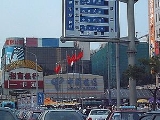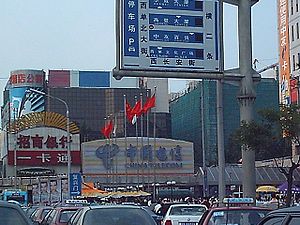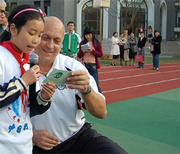
Xidan
Encyclopedia

Beijing
Beijing , also known as Peking , is the capital of the People's Republic of China and one of the most populous cities in the world, with a population of 19,612,368 as of 2010. The city is the country's political, cultural, and educational center, and home to the headquarters for most of China's...
, China
China
Chinese civilization may refer to:* China for more general discussion of the country.* Chinese culture* Greater China, the transnational community of ethnic Chinese.* History of China* Sinosphere, the area historically affected by Chinese culture...
. It is located in the Xicheng District
Xicheng District
Xicheng District is a district in Beijing, China. Xicheng District spans 32 square kilometres, making it the largest portion of the old city , and has 706,691 inhabitants . Its postal code is 100032. Xicheng is subdivided into 15 subdistricts of the city proper of Beijing...
.
The Xidan commercial district incorporates the Xidan Culture Square, North Xidan Street, as well as many supermarkets and department stores. The Xidan Cultural Square is the largest venue for cultural events in downtown Beijing.
Name
The name Xidan (literally, "West Single") came from the paifangPaifang
Paifang, also called pailou, is a traditional Chinese architectural gating style as an archway.The word paifang originally was a collective term used to describe the top two levels of administrative division and subdivisions of ancient Chinese city. The largest division within a city in ancient...
that existed on one of the streets there. In this context, the name "Xidan" refers to the single (单) paifang that existed on the west side (西) of the city.
The paifang was recently rebuilt, and now stands at the Xidan Culture Square.
History
Xidan began to develop in the Ming DynastyMing Dynasty
The Ming Dynasty, also Empire of the Great Ming, was the ruling dynasty of China from 1368 to 1644, following the collapse of the Mongol-led Yuan Dynasty. The Ming, "one of the greatest eras of orderly government and social stability in human history", was the last dynasty in China ruled by ethnic...
as an area alongside the passage for traders from Southwestern China to enter Beijing. Restaurants and shops were eventually built for these merchants. Eventually, as the Western part of the city became the residential area for officials, Xidan became a commercial area. The location of several government agencies when Beijing was under the administration of the Republic of China
Republic of China
The Republic of China , commonly known as Taiwan , is a unitary sovereign state located in East Asia. Originally based in mainland China, the Republic of China currently governs the island of Taiwan , which forms over 99% of its current territory, as well as Penghu, Kinmen, Matsu and other minor...
also helped Xidan's economic growth.
The area began to experience massive growth in the 1950s, as the population of Beijing began to move westwards. By the 1970s, Xidan, along with Qianmen
Qianmen
Qianmen is the colloquial name for Zhengyangmen , a gate in Beijing's historic city wall. The gate is situated to the south of Tiananmen Square and once guarded the southern entry into the Inner City. Although much of Beijing's city walls were demolished, Qianmen remains an important...
and Wangfujing
Wangfujing
Wángfǔjǐng , located in Dongcheng District, Beijing, is one of the Chinese capital's most famous shopping streets. Much of the road is off-limits to cars and other motor vehicles, and it is not rare to see the entire street full of people. Since the middle of the Ming Dynasty there have been...
, became the three major commercial areas in Beijing.
Currently, the area is known throughout Beijing as a shopping area. Many malls and department stores have stores within the area, the oldest of which is the China branch of the Taiwanese department store Chungyo.
Xidan is also home to Lingjing Alley, which, at 32m (34 yards), is considered to be the broadest hutong
Hutong
Hutongs are a type of narrow streets or alleys, most commonly associated with Beijing, China.In Beijing, hutongs are alleys formed by lines of siheyuan, traditional courtyard residences. Many neighbourhoods were formed by joining one siheyuan to another to form a hutong, and then joining one...
in Beijing.
Xidan Wall
Xidan Wall, also called Democracy Wall, is a long brick wall on Xidan Street. Erected in 1978, the event is generally recognized as the beginning of the Beijing SpringBeijing Spring
The Beijing Spring refers to a brief period of political liberalization in the People's Republic of China which occurred in 1977 and 1978. The name is derived from "Prague Spring", an analogous event which occurred in Czechoslovakia in 1968....
. Xidan Wall played a significant role in the democracy movement in Beijing during the summer of 1979. It was at that time where the wall received a significant number of posters that criticized China's leaders. Even an award-winning Canadian
Canada
Canada is a North American country consisting of ten provinces and three territories. Located in the northern part of the continent, it extends from the Atlantic Ocean in the east to the Pacific Ocean in the west, and northward into the Arctic Ocean...
journalist John Fraser
John Fraser (journalist)
John Anderson Fraser, CM , is a Canadian journalist, author and academic who has served as Master of Massey College of the University of Toronto since 1995. As a journalist, Fraser has received multiple national awards and chaired the Canadian Journalism Foundation until 2008. He teaches a course...
put up his own "dazibao
Big-character poster
Big-character posters are handwritten, wall-mounted posters using large-sized Chinese characters, used as a means of protest, propaganda, and popular communication. They have been used in China since imperial times, but became more common when literacy rates rose after the 1911 revolution...
," whose notice about a lost gold signet ring that concluded in vague political sentiment bizarrely resulted in his addressing the 1979 summer masses in Tiananmen Square
Tiananmen Square
Tiananmen Square is a large city square in the center of Beijing, China, named after the Tiananmen Gate located to its North, separating it from the Forbidden City. Tiananmen Square is the third largest city square in the world...
. However, by December 1979, Beijing's municipal government banned the posting of wall posters on Xidan Wall in an attempt to curtail the democracy movement. The municipal government instead allowed allow posters on a site within Yuetan Park, a small park located in Beijing, but required registration with the city and an agreement to be "held responsible for political and legal implications of their messages." Eventually, the most widely regarded poster writer for Xidan Wall, Wei Jingsheng
Wei Jingsheng
Wei Jingsheng is a Chinese activist known for his involvement in the Chinese democracy movement, most prominent for authoring the document Fifth Modernization on the "Democracy Wall" in Beijing in 1978. He is generally known for getting arrested and spending 15 years in prison due to the document...
, was sent to prison.
Transportation
The area is served by the Xidan Subway Station, which is on Line 1Line 1, Beijing Subway
Line 1 of the Beijing Subway is the longest, oldest and busiest line of Beijing's mass transit rail network. It runs underneath Chang'an Avenue, the city's grand east-west thoroughfare, right through the heart of Beijing with stops on either side of Tiananmen Square...
and Line 4
Line 4, Beijing Subway
Line 4 of the Beijing Subway is the 9th subway line in Beijing's mass transit network. It entered into operation on September 28, 2009, and runs from north to south, parallel and to the west of Line 5, through Haidian, Xicheng, Xuanwu and Fengtai Districts in the western half of the city. It is...
of the Beijing Subway
Beijing Subway
The Beijing Subway is a rapid transit rail network that serves the urban and suburban districts of Beijing municipality. It is owned by the city of Beijing and has two operators, the wholly state owned Beijing Mass Transit Railway Operation Corp., which operates 12 lines, and the Beijing MTR...
system. In addition, many Beijing bus lines serve the area.
Future

External links
- Xidan Commercial Street from eBeijing, official website of Beijing government
- The Xidan Street
- Beijing Olympics Page on Xidan
- China.com Page on Xidan
- Xidan Shopping Center

